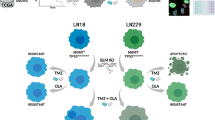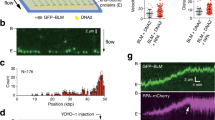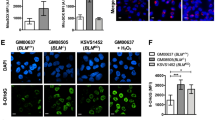Abstract
Bloom’s syndrome (BS) is an autosomal recessive disorder associated with a predisposition to cancers of all types. Cells from BS sufferers display extreme genomic instability. The BS gene product, BLM, is a 159 kDa DNA helicase enzyme belonging to the RecQ family. Here, we have analysed the distribution of BLM in normal and tumour tissues from humans using a recently characterized, specific monoclonal antibody. BLM was found to be localized to nuclei in normal lymphoid tissues, but was largely absent from other normal tissues analysed with the exception of the proliferating compartment of certain tissues. In contrast, expression of BLM was observed in a variety of tumours of both lymphoid and epithelial origin. A strong correlation was observed between expression of BLM and the proliferative status of cells, as determined by staining for markers of cell proliferation (PCNA and Ki67). We conclude that BLM is a proliferation marker in normal and neoplastic cells in vivo, and, as a consequence, is expressed at a higher level in tumours than in normal quiescent tissues. © 2001 Cancer Research Campaign www.bjcancer.com
Similar content being viewed by others
Article PDF
Change history
16 November 2011
This paper was modified 12 months after initial publication to switch to Creative Commons licence terms, as noted at publication
References
Bennett RJ, Sharp JA and Wang JC (1998) Purification and characterization of the Sgs1 DNA helicase activity ofSaccharomyces cerevisiae. J Biol Chem 273: 9644–9650
Brosh RM Jr, Li JL, Kenny MK, Karow JK, Cooper MP, Kureekattil RP, Hickson ID and Bohr VA (2000) Replication protein A physically interacts with the Bloom’s syndrome protein and stimulates its helicase activity. J Biol Chem 275: 23500–23508
Chakraverty RK and Hickson ID (1999) Defending genome integrity during DNA replication: a proposed role for RecQ family helicases. BioEssays 21: 286–294
Dutertre S, Ababou M, Onclercq R, Delic J, Chatton B, Jaulin C and Amor-Gueret M (2000) Cell cycle regulation of the endogenous wild type Bloom’s syndrome DNA helicase. Oncogene 19: 2731–2738
Ellis NA, Groden J, Ye TZ, Straughen J, Lennon DJ, Ciocci S, Proytcheva M and German J (1995) The Bloom’s Syndrome gene product is homologous to RecQ helicases. Cell 83: 655–666
German J (1993) Bloom Syndrome: A mendelian prototype of somatic mutational disease. Medicine 72: 393–406
German J (1995) Bloom’s syndrome. Dermatol Clin 13: 7–18
Gray MD, Shen JC, Kamath-Loeb AS, Blank A, Sopher BL, Martin GM, Oshima J and Loeb LA (1997) The Werner syndrome protein is a DNA helicase. Nat Genet 17: 100–103
Ishov AM, Sotnikov AG, Negorev D, Vladimirova OV, Neff N, Kamitani T, Yeh ETH, Strauss, III JF and Maul GC (1999) PML is critical for ND10 formation and recuits the PML-interacting protein Daxx to this nuclear structure when modified by SUMO-1. J Cell Biol 147: 221–233
Karow JK, Chakraverty RK and Hickson ID (1997) The Bloom’s syndrome gene product is a 3′–5′ DNA helicase. J Biol Chem 272: 30611–30614
Karow JK, Wu L and Hickson ID (2000a) RecQ family helicases: roles in cancer and aging. Curr Opin Genet Dev 10: 32–38
Karow JK, Constantinou A, Li J-L, West SC and Hickson ID (2000b) The Bloom’s syndrome gene product promotes branch migration of holliday junctions. Proc Natl Acad Sci USA 97: 6504–6508
Kitao S, Shimamoto A, Goto M, Miller RW, Smithson WA, Lindor NM and Furuichi Y (1999) Mutations in RECQL4 cause a subset of cases of Rothmund-Thomson syndrome. Nat Genet 22: 82–84
Puranam LL and Blackshear PJ (1994) Cloning and characterisation of RECQL, a potential human homologue of the Escherichia coli DNA helicase RecQ. J Biol Chem 269: 29838–29845
Seki M, Miyazawa H, Tada S, Yanagisawa J, Yamaoka T, Hoshino S, Ozawa K, Eki T, Nogami M, Okumura K, Taguchi H, Hanaoka F and Enomoto T (1994) Molecular cloning of cDNA encoding human DNA helicase Q1 which has homology to Escherichia coli RecQ helicase and localization of the gene at chromosome 12p12. Nucleic Acids Res 22: 4566–4573
Shen JC, Gray MD, Oshima J and Loeb LA (1998) Characterization of Werner syndrome protein DNA helicase activity: directionality, substrate dependence and stimulation by replication protein A. Nucleic Acids Res 26: 2879–2885
Suzuki N, Shimamoto A, Imamura O, Kuromitsu J, Kitao S, Goto M and Furuichi Y (1997) DNA helicase activity in Werner’s syndrome gene product synthesized in a baculovirus system. Nucleic Acids Res 25: 2973–2978
Umezu K and Nakayama H (1993) RecQ DNA helicase of Escherichia coli. Characterization of the helix-unwinding activity with emphasis on the effect of single-stranded DNA-binding protein. J Mol Biol 230: 1145–1150
Wu L, Davies SL, North PS, Goulaouic H, Riou JF, Turley H, Gatter KC and Hickson ID (2000a) The Bloom’s syndrome gene product interacts with topoisomerase III. J Biol Chem 275: 9636–9644
Wu L, Davies SL and Hickson ID (2000b) Roles of RecQ family helicases in the maintenance of genome stability. Cold Spring Harbor Symposium of Quantitative Biology 65: 573–581
Yankiwski V, Marciniak RA, Guarente L and Neff NF (2000) Nuclear structure in nomal and Bloom syndrome cells. Proc Natl Acad Sci USA 97: 5214–5219
Yu C, Oshima J, Fu Y, Wijsman EM, Hisama F, Alisch R, Matthews S, Najura J, Miki T, Ouais S, Martin GM, Mulligan J and Schellenberg GD (1996) Positional cloning of the Werner’s syndrome gene. Science 272: 258–262
Zhong S, Hu P, Ye T-Z, Stan R, Ellis NA and Pandolfi PP (1999) A role for PML and the nuclear body in genomic stability. Oncogene 18: 7941–7947
Author information
Authors and Affiliations
Rights and permissions
From twelve months after its original publication, this work is licensed under the Creative Commons Attribution-NonCommercial-Share Alike 3.0 Unported License. To view a copy of this license, visit http://creativecommons.org/licenses/by-nc-sa/3.0/
About this article
Cite this article
Turley, H., Wu, L., Canamero, M. et al. The distribution and expression of the Bloom’s syndrome gene product in normal and neoplastic human cells. Br J Cancer 85, 261–265 (2001). https://doi.org/10.1054/bjoc.2001.1874
Received:
Revised:
Accepted:
Published:
Issue date:
DOI: https://doi.org/10.1054/bjoc.2001.1874
This article is cited by
-
A CK2 and SUMO-dependent, PML NB-involved regulatory mechanism controlling BLM ubiquitination and G-quadruplex resolution
Nature Communications (2023)
-
Screening antiproliferative drug for breast cancer from bisbenzylisoquinoline alkaloid tetrandrine and fangchinoline derivatives by targeting BLM helicase
BMC Cancer (2019)
-
DNA helicases involved in DNA repair and their roles in cancer
Nature Reviews Cancer (2013)
-
The human RECQ1 helicase is highly expressed in glioblastoma and plays an important role in tumor cell proliferation
Molecular Cancer (2011)
-
BLM helicase is activated in BCR/ABL leukemia cells to modulate responses to cisplatin
Oncogene (2005)



